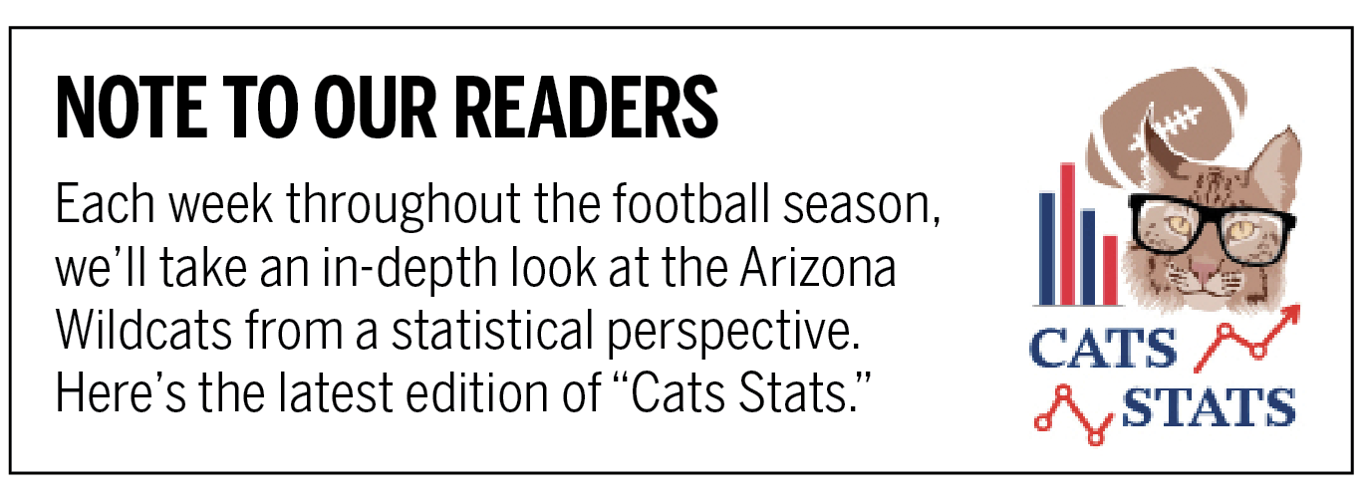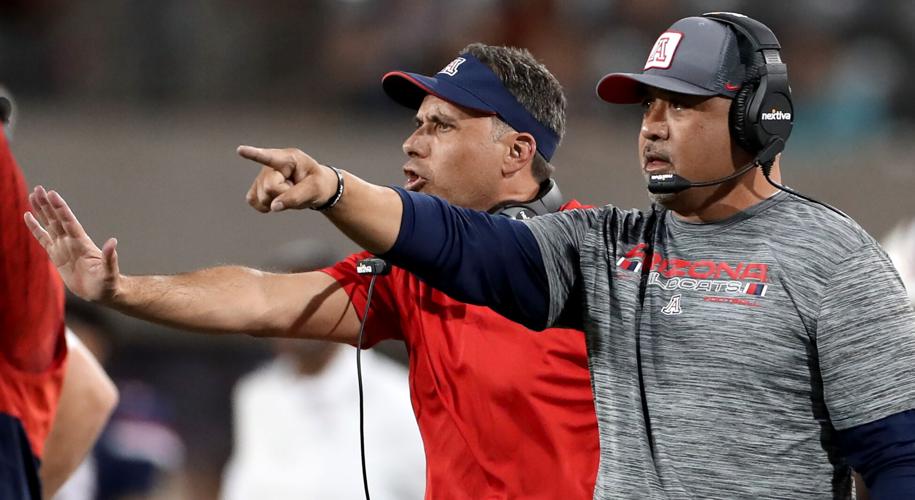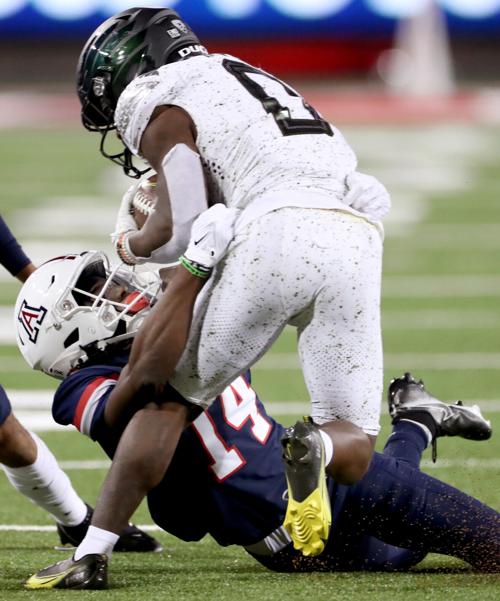On the surface, Arizona’s defensive performance against Oregon looked a lot like the one against Cal.
In both games, the Wildcats allowed 49 points. The Ducks had 306 rushing yards and 580 total yards; the Golden Bears had 354 rushing yards and 599 total yards.
Both performances were bad, without question. But they weren’t the same.
“I think it was two different type games,” UA coach Jedd Fisch said in the aftermath of last week’s 49-22 loss to Oregon. “This one was more along the lines of: They got better angles on us. We didn’t find a way to get into the gaps the way we wanted to. We weren’t able to affect them. We weren’t able to take them out of any rhythm.
“When you can’t take a team out of rhythm, you wind up putting yourself in a position where you’re always behind the eight ball. That’s what it felt like — that it was second-and-2, third-and-1, second-and-3 ... or first-and-10, first-and-10. So you can call what you want. And when you can call what you want as a play-caller, you have a big advantage over the defense.”

Fisch wasn’t imagining things, as you’re about to find out in this week’s pre-Washington edition of “Cats Stats.” The Oregon game had some unique elements to it. If you’re an Arizona fan, you’re hoping it was an outlier and not a sign of what’s to come.
To Fisch’s point about never taking the Ducks out of their rhythm, the numbers bear that out. Oregon averaged 9.9 yards per play on first down, according to StatBroadcast. That’s the highest figure for a UA opponent this season, and it’s not even close. Here are the others:
San Diego State: 3.6
Mississippi State: 6.7
North Dakota State: 6.8
Cal: 6.5
Colorado 4.2
The only comparable number in a UA game this season was produced by the Wildcats, who averaged 9.5 yards on first-down plays against the Buffaloes.
Because they were so efficient, the Ducks seldom faced stressful third-down situations – or any third-down situations.
Oregon’s average distance to go on third down was 5.3 yards, the second lowest for a UA opponent this season (NDSU, 5.0). The Ducks didn’t face a true third-and-long — 9-plus yards — a single time. Half of their eight third downs required 4 or fewer yards.
That Oregon faced only eight third downs is also noteworthy. It’s the second-fewest third downs for a UA foe this season and the third time an opponent has faced fewer than 10. That happened only once last season, in the finale vs. Arizona State. (We bring this up because the Johnny Nansen vs. Don Brown debate is still raging and won’t be ending anytime soon.)
What’s the significance of a team’s third-down attempts? Simply put, if an offense isn’t facing a significant number of third downs, that means the defense isn’t getting stops to create those scenarios.
NDSU faced only seven third downs. Why so low, given that the Bison averaged about 3 fewer yards per first-down play than the Ducks? We’re chalking that up to NDSU’s deliberate pace of play. The Bison ran the fewest plays (57) of any UA opponent this season despite having an edge in time of possession.
The Cal game was the other one in which the opposition faced fewer than 10 third downs. It was a precursor to Oregon in some ways, but not in others.
The Wildcats did put the Golden Bears into some uncomfortable situations. Cal needed 9 or more yards in four third-down scenarios and converted only one. The Bears’ average distance to gain a first down was 7.6 yards – the highest of any UA opponent this season.
What doomed Arizona that afternoon in Berkeley was big plays. Cal had nine rushes of 10-plus yards, including a pair of 70-plus-yard touchdowns by Jaydn Ott. He also had a 31-yard run . Those nine rushing plays netted 254 yards.

Arizona coach Jedd Fisch, left, and defensive coordinator Johnny Nansen stayed busy during last weekend's loss to Oregon.
Oregon had 10 rushing plays of 10-plus yards, totaling 199 yards. Those figures were similar to NDSU’s (11-195). Both teams gained yardage on the ground in chunks. The Wildcats were able to get a handful of stops vs. the Bison at the end of the game. They couldn’t halt the Ducks for seven straight possessions, creating an insurmountable deficit.
Oregon was in so many favorable down-and-distance situations that quarterback Bo Nix barely had to throw the ball downfield. Only six of his pass attempts were thrown 10 or more yards downfield, according to Pro Football Focus. He was highly efficient on passes thrown 20-plus yards, connecting on 3 of 4 for 99 yards.
The other statistic that jumps out from the Oregon game is Arizona’s tackles for losses. The Wildcats had none.
How unusual is that? The last time Arizona failed to register a TFL was Sept. 17, 2011, against Stanford, according to Sports-Reference.com’s game-finder tool.
Think of all the wretched UA defensive performances between then and now. Only twice did the Wildcats have one TFL during that span – a 69-7 loss at Washington State in 2016 and ... a 58-37 win vs. WSU in ’17. Arizona had four interceptions in the 2017 game. It also had Khalil Tate in the midst of his historic run.
Even in the utterly dismal 2020 finale against Arizona State — arguably the lowest point in program history — the Wildcats managed two TFLs.
It’s really hard to play good defense when the game is being played entirely on one side of the line of scrimmage. In our second viewing of the contest, we noted only a handful of instances in which the UA defense was able to penetrate the Oregon backfield. One play resulted in a gain of 1 yard. Another ended with Jalen Harris batting down a pass.
Arizona did have one stop for no gain, courtesy of safety Christian Young, on Oregon’s final possession. The Wildcats failed to sack Nix — although, it should be noted, he has been sacked only one time this season. Nix might be the best QB in the nation at avoiding sacks. Combine that with Oregon’s elite offensive line – the best pass-blocking group in the country, per PFF — and posting a zero in the sack column is not a surprising outcome.
But no TFLs of any kind? That’s troubling. Much blame has been placed on the linebackers for Arizona’s run-defense woes, but the defensive line has to do its part as well.
Washington has yielded 18 TFLs in six games, including five sacks, tied for second fewest in the Pac-12. If the Wildcats can’t get into the Huskies’ backfield — if they can’t disrupt their rhythm — it’s going to be a long afternoon in Seattle.







